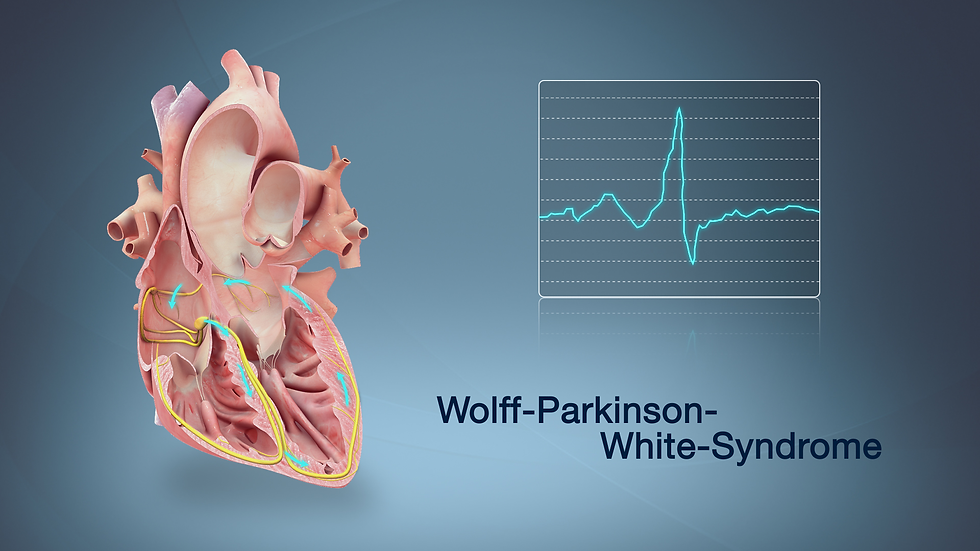What Are the Latest Advances in WPW Syndrome Treatment?
- theheartae
- Aug 25
- 4 min read
Wolff-Parkinson-White (WPW) syndrome is a rare but significant heart condition that causes episodes of rapid heartbeat due to an extra electrical pathway in the heart. While it can occur at any age, WPW syndrome is often diagnosed in young people and athletes, making early recognition and treatment essential. Over the years, cardiology has made significant progress in managing this condition, leading to safer, faster, and more effective options for patients.
In this article, we will explore the latest advances in WPW syndrome treatment, how they benefit patients, and why choosing expert care providers is crucial for long-term heart health.
Understanding WPW Syndrome
WPW syndrome occurs when an extra electrical connection, called an accessory pathway, bypasses the heart’s normal conduction system. This can cause episodes of supraventricular tachycardia (SVT), where the heart beats abnormally fast. Symptoms may include:
Palpitations
Dizziness or fainting
Shortness of breath
Chest discomfort
Sudden fatigue during activity
While some individuals may never experience symptoms, WPW can occasionally lead to serious complications if left untreated. This is why early diagnosis and advanced care are vital.

Traditional WPW Syndrome Treatment Approaches
Historically, WPW syndrome treatment relied on two main strategies:
Medications – Antiarrhythmic drugs such as procainamide or flecainide were often prescribed to control abnormal rhythms. However, long-term use could have side effects, and results were not always permanent.
Surgical Procedures – Before modern techniques, open-heart surgery was used to remove or block the accessory pathway. Although effective, it was highly invasive and required significant recovery time.
Thankfully, with modern cardiology, these older approaches have largely been replaced by safer and more advanced options.
Latest Advances in WPW Syndrome Treatment
1. Catheter Ablation – A Minimally Invasive Gold Standard
Catheter ablation has become the frontline treatment for WPW syndrome. Using thin, flexible tubes inserted through blood vessels, cardiologists target and destroy the abnormal electrical pathway with radiofrequency energy or cryotherapy.
Recent improvements include:
High-precision 3D mapping systems that allow doctors to locate the accessory pathway with extreme accuracy.
Cryoablation technology, which uses freezing instead of heat, minimizing the risk of damaging surrounding tissue.
Shorter recovery times, allowing patients to return home within 24 hours.
Studies show that catheter ablation now has success rates of over 95%, with very low recurrence.
2. Advanced Electrophysiology Studies (EPS)
Electrophysiology studies have advanced significantly with real-time imaging and digital mapping tools. These allow cardiologists to observe electrical activity within the heart during procedures, ensuring the accessory pathway is correctly identified. Modern EPS has made catheter ablation even safer and more effective, especially for complex cases.
3. Wearable Heart Monitoring Devices
Monitoring plays a crucial role in both diagnosis and aftercare. Today, wearable devices such as smart ECG patches and continuous rhythm monitors provide real-time data on a patient’s heart activity. This innovation helps physicians detect WPW-related arrhythmias early and tailor treatment plans more effectively.
4. Personalized Treatment Plans
Thanks to precision medicine, WPW syndrome treatment is now more customized than ever. Genetic testing, advanced imaging, and patient-specific risk assessments allow cardiologists to design individualized care strategies. This ensures that treatment is not only effective but also safe for each patient’s unique health condition.
5. Safer Sedation and Anesthesia Practices
For younger patients, especially children, undergoing ablation can be intimidating. Advances in sedation and anesthesia techniques now ensure that procedures are less stressful, with better pain management and faster recovery.
6. Telemedicine and Remote Consultations
Post-treatment follow-up is just as important as the procedure itself. With telemedicine, patients can now have regular check-ups with their cardiologists from the comfort of their home. This is particularly beneficial for patients in remote areas, ensuring they receive ongoing care without unnecessary travel.
Benefits of Modern WPW Syndrome Treatment
The latest advancements offer patients several life-changing benefits, including:
High success rates with minimal risk of recurrence.
Faster recovery times, often with same-day or next-day discharge.
Lower complication risks compared to older methods.
Improved quality of life, with reduced symptoms and better heart rhythm stability.
Long-term safety, as many patients can live symptom-free without needing daily medication.
Aftercare and Lifestyle Guidance
Even after successful treatment, patients are advised to maintain a heart-healthy lifestyle. This includes:
Avoiding excessive caffeine and alcohol
Managing stress through relaxation techniques
Following up with routine check-ups
Staying physically active within recommended limits
Wearing monitoring devices if suggested by a doctor
Proper aftercare ensures that patients remain symptom-free and reduces the chance of arrhythmia recurrence.
Why Choose Expert Care for WPW Syndrome Treatment?
When it comes to heart rhythm disorders, experience and technology make all the difference. Clinics with advanced electrophysiology labs, skilled cardiologists, and personalized care approaches ensure the best outcomes for patients.
The Heartae is a trusted provider of advanced cardiac care, offering state-of-the-art facilities and expertise in WPW syndrome treatment. With a patient-centered approach, innovative technology, and highly experienced specialists, The Heartae ensures that individuals receive safe, effective, and long-term solutions for their heart rhythm disorders.
Conclusion
The field of cardiology has seen remarkable progress in recent years, especially in the management of WPW syndrome. From high-precision catheter ablation to advanced wearable monitors and personalized treatment plans, patients now have access to safer, faster, and more effective care than ever before.
If you or your loved ones are experiencing symptoms of WPW syndrome, seeking timely medical evaluation is essential. With the latest advances in WPW syndrome treatment and the expertise available at The Heartae, patients can look forward to healthier hearts and better quality of life.



Comments